Common Spiders Found in North Carolina

Spiders are a year-round reality for North Carolina homeowners, thanks to the state’s warm and humid climate. While most spiders are harmless and even helpful in controlling insect populations, some can be unsettling—or, in rare cases, dangerous. Being able to recognize the spiders you may find indoors or around your property can help you respond appropriately.
Are Spiders in North Carolina Dangerous?
The majority of spiders in North Carolina pose no threat to people or pets. However, a few species, such as the Black Widow and Brown Recluse, can deliver bites that require medical attention. Even non-venomous spiders can become a nuisance when they multiply indoors. Knowing which species are harmless and which require caution can help you protect your home and family.
Common Spiders Found in North Carolina
Black Widow Spider

One of the most well-known venomous spiders, the Black Widow is shiny black with a distinctive red hourglass on its abdomen. Females are more dangerous than males and typically stay hidden in dark, undisturbed areas like woodpiles, crawl spaces, and garages. A bite can cause severe pain, muscle cramps, and nausea, requiring medical attention.
- Appearance: Shiny black body with a round abdomen and a red or orange hourglass marking underneath.
- Size: About 1.5 inches including legs.
- Behavior: Reclusive and non-aggressive unless disturbed.
- Where They Hide: In dark, quiet areas like woodpiles, sheds, crawl spaces, garages, and underneath outdoor furniture.
- Danger Level: High – their venom can cause muscle cramps, pain, and nausea. Bites require medical attention.
Brown Recluse Spider

The Brown Recluse is light to medium brown with a violin-shaped marking on its back. It prefers secluded, dry, and dark environments like closets, attics, or behind furniture. While bites are rare, they can result in serious skin damage or systemic reactions, especially if untreated.
- Appearance: Light to medium brown with a dark, violin-shaped marking on its back.
- Size: Roughly the size of a quarter including legs.
- Behavior: Shy and prefers to avoid contact with humans.
- Where They Hide: In dry, undisturbed places like attics, behind wall hangings, in closets, under furniture, and inside shoes or clothing left on the floor.
- Danger Level: High – venom can cause serious skin damage. Bites should be evaluated by a doctor.
Wolf Spider
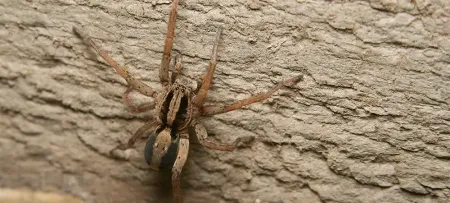
Large and fast-moving, Wolf Spiders can look intimidating but are not considered dangerous. They don’t spin webs and are active hunters, often found indoors in basements or garages. Bites are uncommon and typically cause mild irritation.
- Appearance: Brown to gray with darker markings, hairy, and large-bodied.
- Size: 1 to 2 inches, with some appearing even larger.
- Behavior: Hunts prey instead of spinning webs. Fast-moving and may appear to “chase” if startled.
- Where They Hide: Near doors, in garages, basements, under leaves, or in tall grass outside.
- Danger Level: Low – bite may cause mild irritation but they are not aggressive.
Jumping Spider
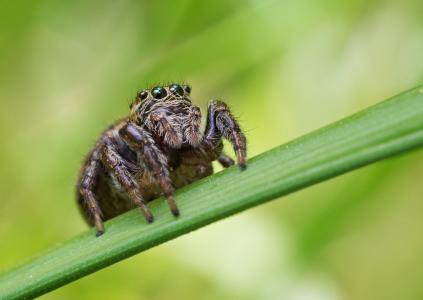
Jumping Spiders are small, fuzzy, and known for their quick, jerky movements and excellent vision. They often have bright or iridescent coloring. These spiders are harmless and more curious than aggressive, frequently seen on windowsills or walls hunting for insects.
- Appearance: Compact body, often black or brown with iridescent or white markings. Large front-facing eyes.
- Size: 1/4 to 3/4 inch.
- Behavior: Active during the day. Known for sudden jumping movements when hunting.
- Where They Hide: On windowsills, door frames, houseplants, or walls—usually chasing small insects.
- Danger Level: None – curious but harmless.
Cellar Spider (Daddy Longlegs)
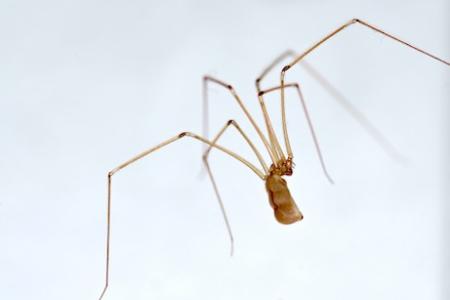
Often confused with harvestmen (which are not true spiders), Cellar Spiders have long, thin legs and small bodies. They thrive in damp, dark places like basements and crawl spaces. Harmless to humans, they are beneficial in reducing populations of other insects and spiders.
- Appearance: Very long, thin legs with a tiny gray or beige body.
- Size: Leg span can be up to 2 inches.
- Behavior: Builds loose, irregular webs in corners. Vibrates rapidly in place when disturbed.
- Where They Hide: In basements, crawl spaces, ceiling corners, and under sinks.
- Danger Level: None – completely harmless to humans.
Orb-Weaver Spider
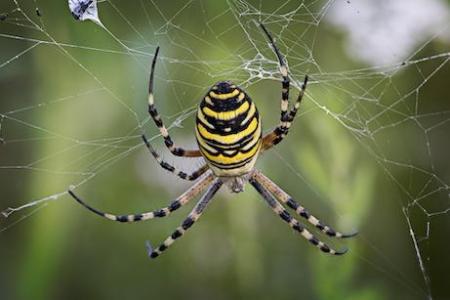
Orb-Weavers are garden dwellers known for their intricate, circular webs. They come in various colors and patterns and are usually seen outdoors in shrubs, gardens, and between trees. These spiders are non-aggressive and pose no threat to humans.
- Appearance: Often bright-colored with distinctive patterns; large, rounded abdomen.
- Size: ½ to 1 inch body, legs much longer.
- Behavior: Builds large, wheel-shaped webs outdoors, often seen at night or early morning.
- Where They Hide: In gardens, on porches, between trees, or along fence lines.
- Danger Level: None – beneficial and non-aggressive.
Sac Spider
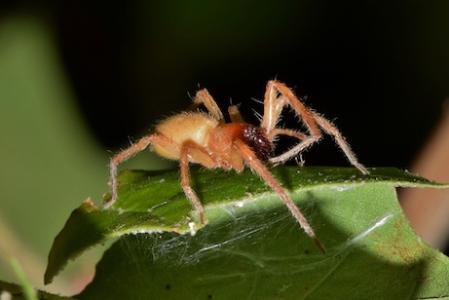
Pale yellow or beige, Sac Spiders build silk sacs instead of webs and are active at night. They often hide in wall voids, ceiling corners, and behind baseboards. Their bite can cause mild skin irritation, though it is rarely serious.
- Appearance: Pale yellow or beige, slender body.
- Size: Around 1/4 to 3/8 inch.
- Behavior: Active at night; doesn't spin webs but builds silk sacs where it hides during the day.
- Where They Hide: Ceiling corners, under baseboards, inside window frames, and under leaves.
- Danger Level: Mild – bites may cause minor skin irritation.
Where Are You Most Likely to Find Spiders in NC Homes?
Spiders can be commonly found in homes in these areas:
- Basements and crawl spaces
- Garages and storage areas
- Attics and ceiling corners
- Closets and clothing piles
- Behind or under furniture
- Around windows, vents, and light fixtures
- Under sinks or near plumbing
- Outdoor structures like sheds or woodpiles
Tips to Prevent Spiders Indoors
Spiders often find their way indoors in search of food, shelter, or more favorable conditions. While most are harmless, their presence can be unsettling. Fortunately, there are several simple steps you can take to make your home less inviting to spiders:
- Seal Entry Points: Use caulk or weather stripping to close gaps around windows, doors, and foundations.
- Keep Your Home Clutter-Free: Less clutter means fewer hiding spots for spiders.
- Vacuum Regularly: Focus on corners, behind furniture, under beds, and ceiling areas.
- Reduce Outdoor Lighting: Lights attract insects, which in turn attract spiders.
- Use Screens: Ensure that window and door screens are intact and free from tears.
- Store Firewood Away from Your Home: Keep it at least 20 feet from your house and off the ground.
- Keep Vegetation Trimmed: Trim shrubs and trees so they don’t touch your home’s exterior.
When to Call a Pest Control Professional
If you've identified venomous spiders like the Black Widow or Brown Recluse, or if spiders are consistently appearing indoors despite your prevention efforts, it’s time to call in the experts. At Pest-X, we specialize in comprehensive pest control services. Our licensed technicians can inspect your property, eliminate existing spider populations, and help you prevent future infestations—so you can feel confident and comfortable in your home.
Contact Pest-X today for a customized spider treatment plan designed to fit your home and your peace of mind.
